Hole in the Clouds
Jan 14, 2010

Carol and Sandy Fuchs spent a week in northern Sweden recently, including New Year's at the Ice Hotel near Kiruna, about 100 miles north of the Arctic Circle. The sun never rose above the horizon the whole time they were up there, though the dark of night faded into a sort of twilight for a few hours in the middle of each day.
They tried dogsledding and snowmobiling and visited with reindeer herders. The town of Kiruna is a thriving iron-mining center, where the hundred-year-old mine is nowhere near played out; it is currently expanding closer and closer to the town, which is gradually being relocated to escape the blasting and other mine activity.
The basic structure of the Ice Hotel is made of snow; in November each year, snowguns spray artifical snow over arched metal forms, which are removed after a couple of days, leaving igloo-like tunnels. Interior walls are made of two-ton ice blocks cut from the Torne River and returned to the river when the place starts to melt in April or May. The ice is cut in March and stored for the next winter's construction.
Beds are platforms of ice and snow covered with reindeer hides. Guests sleep in sleeping bags. There are ice sculptures and specially carved ice chairs and tables in the rooms, but according to Carol guests don't usually spend much time lolling about in chairs made of ice. Although she slept well, she reports that Sandy hardly slept at all; he was worried that if he relaxed and closed his eyes, he'd freeze to death and never wake up. The room temperature was about minus 5 Celsius, or 23 degrees Fahrenheit.
The hotel has an ice bar, where drinks are served in glasses made of ice. There's also a restaurant, which serves hot food on regular dishes, in front of a blazing fire.
I'm thinking that part of the rationale for a winter vacation in Arctic Sweden is that it must feel pretty good when you leave; wherever you spend the rest of your winter, even if it's in what you normally consider a fairly wintry sort of place, must seem bright and sunny and maybe even toasty by comparison.
night
Sweden
winter
snow
Sandy Fuchs
Kiruna
ice
Arctic Circle
(Image credit: Carol Fuchs)
Nov 18, 2010

As winter descends upon us in the northern mid-latitudes, the summer sun is beginning to bake the Antarctic peninsula, which angles northward from the Antarctic continent toward South America. This part of Antarctica has warmed up substantially in recent years and is currently shedding its sea ice.
When Sir Ernest Shackleton approached this peninsula during a polar expedition about a century ago, his ship was trapped by sea ice and held fast for more than two years, before being crushed to splinters. In today's climate, a ship could sail freely throughout most of the peninsular region--and it's still springtime in Antarctica, not quite full summer yet.
This picture was taken two days ago by a circumpolar satellite. It shows a few bits of bare brownish ground and several large blue patches, which represent weakened sea ice flooded by meltwater. Relatively warm westerly winds have been breaking up the ice cover and blowing bergs and mini-bergs eastward out to sea.
At the left edge of this picture is a horseshoe-shaped island that is probably a volcanic crater. The Antarctic Peninsula is a mountain range, with peaks and ridges that poke up above the waters of the Southern Ocean. These mountains have been snow-covered for tens of thousands of years, but tune in later this winter/summer to see if we can catch a glimpse of newly naked land hereabouts.
ice
Antarctica
(Image credit: NASA ASTER satellite)
Jul 23, 2011
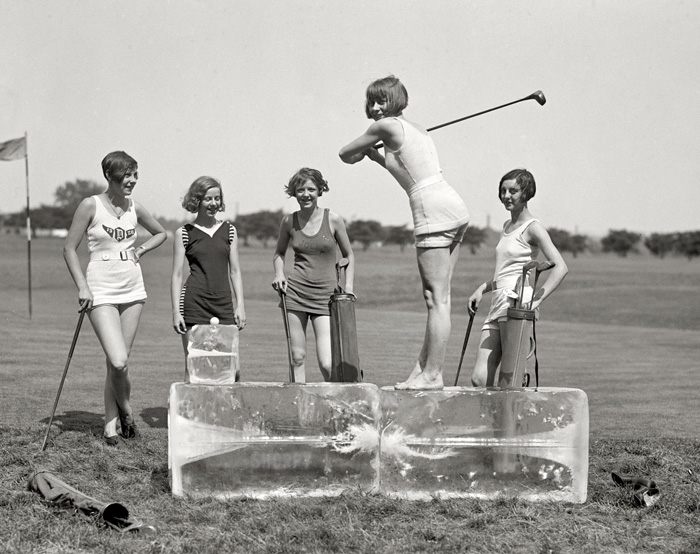 On July 11, 1926, the Washington Post published this publicity shot for "the Gladyse Wilbur girls," a song-and-dance troupe that did its singing and dancing, as well as its teeing off, in bathing costumes. That's Dorothy Kelly on ice, backed up by Virginia Hunter, Elaine Griggs, Hazel Brown, and Mary Kaminsky.
On July 11, 1926, the Washington Post published this publicity shot for "the Gladyse Wilbur girls," a song-and-dance troupe that did its singing and dancing, as well as its teeing off, in bathing costumes. That's Dorothy Kelly on ice, backed up by Virginia Hunter, Elaine Griggs, Hazel Brown, and Mary Kaminsky.
The show was in Keith's Theater in Washington, which may have been air conditioned by 1926. The ice in the photo is obviously intended to suggest that the Gladyse Wilbur girls can be enjoyed in cool comfort, even in the middle of the summer.
sports
Washington
summer
ice
Virginia
Dorothy
bathing suits
District of Columbia
Elaine
golf
Mary
Hazel
(Image credit: National Photo Company, via Shorpy)
Jan 1, 2012
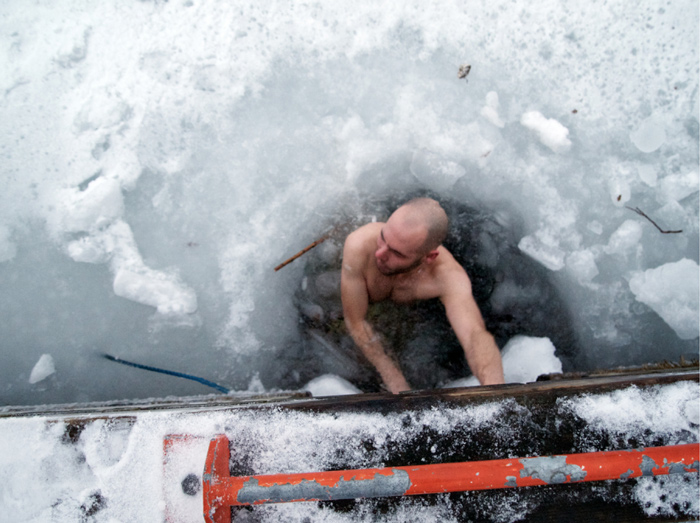 Some people, sometimes including some of my sons, bring in the new year this way. Maybe after a start like this, the rest of the year doesn't seem quite so rough.
Some people, sometimes including some of my sons, bring in the new year this way. Maybe after a start like this, the rest of the year doesn't seem quite so rough.
But I say that's much too low a standard for 2012. Next year should be way, way, way better than an icy plunge, and way, way, way better than 2011, and just plain awesome. I lift my glass to good times all through 2012: love, warmth, health, wit, serendipity, hope against hope, and great kindness. Cheers.
winter
ice
New Year's
swim
Jun 20, 2012
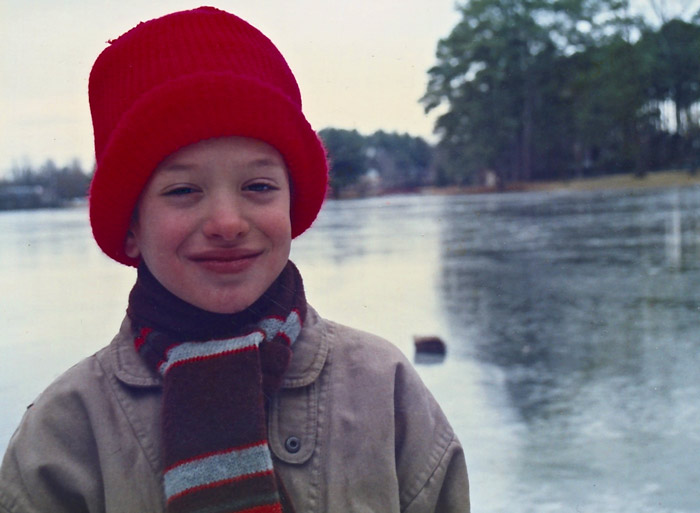 They say we could hit 100 today, or if not today then tomorrow. Which of course brings to mind the proverbial cold day in . . . Alabama, back in approximately 1989, when Forest Lake froze over solid and young Ted put on a scarf and a red hat and went out for an adventure on ice. You may be able to make out a dark blob just behind his left shoulder; that was a log we put out to set a limit on the adventure; beyond that point, we weren't sure how thin the ice might be, and Alabama kids didn't know from thin ice.
They say we could hit 100 today, or if not today then tomorrow. Which of course brings to mind the proverbial cold day in . . . Alabama, back in approximately 1989, when Forest Lake froze over solid and young Ted put on a scarf and a red hat and went out for an adventure on ice. You may be able to make out a dark blob just behind his left shoulder; that was a log we put out to set a limit on the adventure; beyond that point, we weren't sure how thin the ice might be, and Alabama kids didn't know from thin ice.
The thing about a cold day in Alabama is: if it's cold enough to freeze a lake, it's certainly cold enough to freeze everybody's plumbing, which is not insulated well enough to function in serious winter. We had an ax that we used to chop holes in that ice so we could get buckets of water to keep the toilet flushing.
Tuscaloosa
Alabama
kids
Forest Lake
winter
Ted
ice
Mar 21, 2013
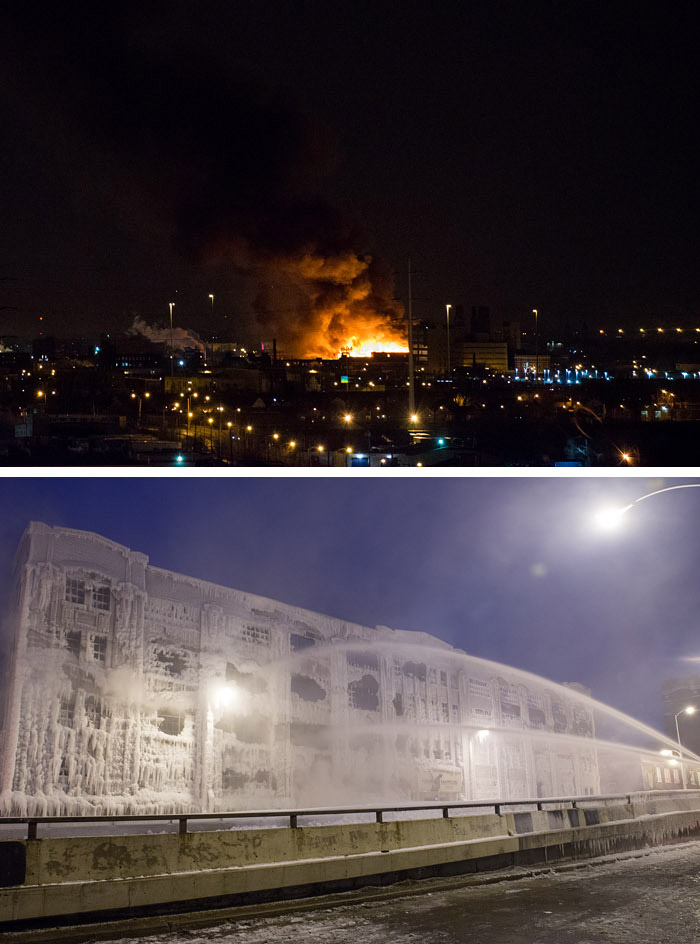 On a cold night in January, more than two hundred firefighters from all over Chicago battled a huge blaze in the Harris Marcus warehouse in the city's Bridgeport district. The job was complicated by extreme cold, as hydrants froze and ladders iced up; the water department was called in to de-ice the ladders with steamers.
On a cold night in January, more than two hundred firefighters from all over Chicago battled a huge blaze in the Harris Marcus warehouse in the city's Bridgeport district. The job was complicated by extreme cold, as hydrants froze and ladders iced up; the water department was called in to de-ice the ladders with steamers.
The next day, embers in the smouldering ruin reignited, and firetrucks had to go back there and spray even more water.
cityscape
Chicago
birdseye view
Illinois
winter
ice
fire
night and day
(Image credit: Archie Florcruz)
Feb 17, 2014
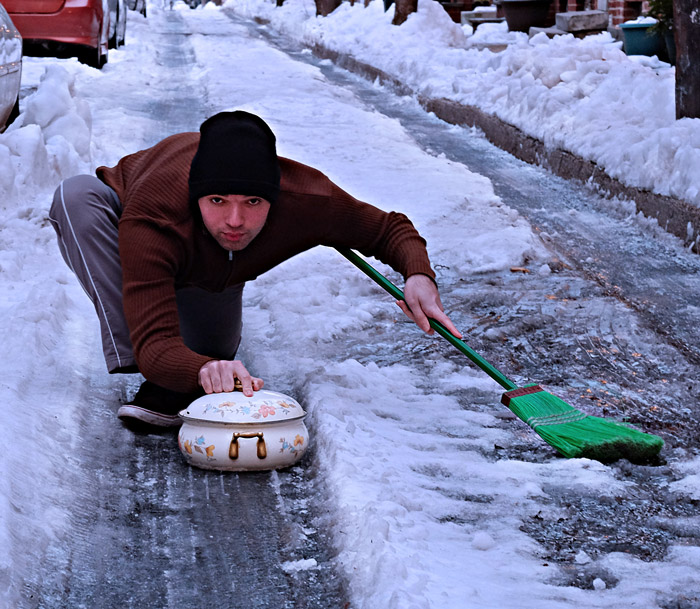 Marco's rock is right on track for the U.S. of A.
Marco's rock is right on track for the U.S. of A.
sports
streetscape
winter
snow
ice
Kater Street
neighborhood
Marco Bonnes
Olympics
broom
(Image credit: Little Fuji)
Nov 9, 2014
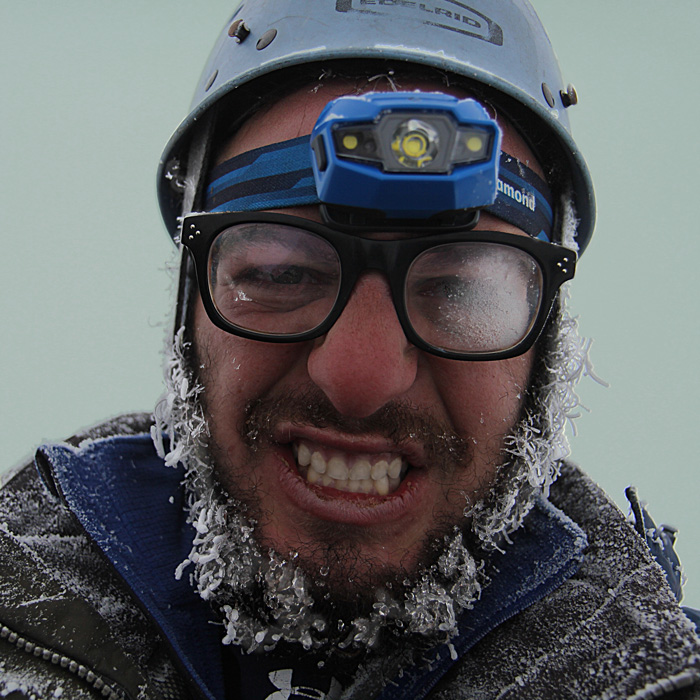 On August 13, Hank and about a dozen other climbers summited Yanaphaqcha, an 18,000-foot peak in the Cordillera Blanca range of the Peruvian Andes. As they neared the top of the mountain, they were engulfed in thick clouds spitting snow. "What you see around me in the picture," Hank says, "that was the view from the top."
On August 13, Hank and about a dozen other climbers summited Yanaphaqcha, an 18,000-foot peak in the Cordillera Blanca range of the Peruvian Andes. As they neared the top of the mountain, they were engulfed in thick clouds spitting snow. "What you see around me in the picture," Hank says, "that was the view from the top."
snow
ice
mountain
summit
climbing
Peru
Yanaphaqcha
Cordillera Blanca
mountaineering
(Image credit: Hank Stein)
Jan 7, 2015
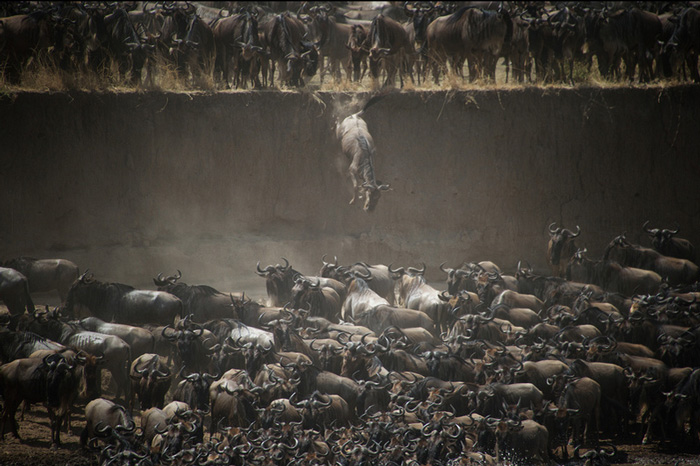 Above, wildebeest cross the Mara River during their annual migration northward from the Serengeti in Tanzania to the Masai Mara in Kenya. An estimated two million animals, mostly wildebeest but also including hundreds of thousands of Thompson's gazelle, zebra, and eland, make this long trek every year during the dry season, as they seek greener pastures; their navigation techniques are not fully understood, but one strategy they seem to follow is to head toward thunder and lightning.
Above, wildebeest cross the Mara River during their annual migration northward from the Serengeti in Tanzania to the Masai Mara in Kenya. An estimated two million animals, mostly wildebeest but also including hundreds of thousands of Thompson's gazelle, zebra, and eland, make this long trek every year during the dry season, as they seek greener pastures; their navigation techniques are not fully understood, but one strategy they seem to follow is to head toward thunder and lightning.
This photo, by Nicole Cambre, took first place in the "Nature" category of National Geographic's 2014 photo competition, which attracted more than 10,000 entrants from 150 different countries.
Below, ice on a window in Tabasalu, Estonia, propagates in a crystal form that the photographer, Maie Kinmann, calls "Dragon." This photo won honorable mention in the "Nature" category.

Estonia
National Geographic
ice
window
Mara River
wildebeest
Tanzania
Tabasalu
migration
Serengeti
(Image credits: top,Nicole Cambre; bottom, Maie Kinmann)
Mar 11, 2016
 On the afternoon of March 7, 2009, the ice went out on the White River in South Royalton, Vermont. For hours, the river roared and groaned, as its thick cover of winter ice was ground to bits by rampaging ice chunks from miles upstream. By the next morning, the river ran free, except along the banks, where rocks and logs had snagged some of the frozen slabs and beached them on dry land. Over the next few weeks, the jumble of beached ice melted very slowly, and then it was really spring.
On the afternoon of March 7, 2009, the ice went out on the White River in South Royalton, Vermont. For hours, the river roared and groaned, as its thick cover of winter ice was ground to bits by rampaging ice chunks from miles upstream. By the next morning, the river ran free, except along the banks, where rocks and logs had snagged some of the frozen slabs and beached them on dry land. Over the next few weeks, the jumble of beached ice melted very slowly, and then it was really spring.
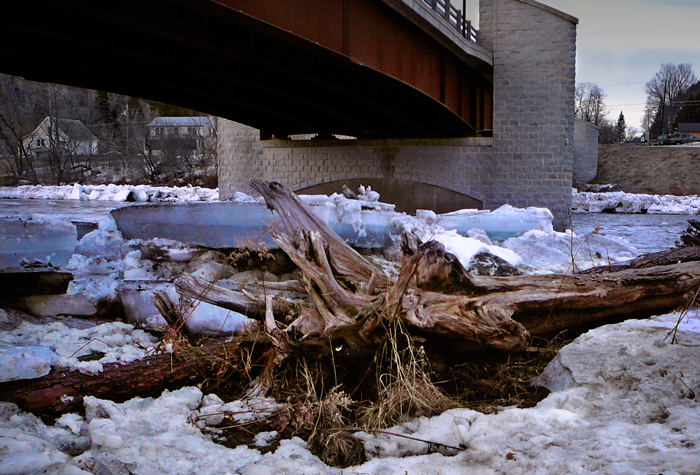
winter
ice
Vermont
spring
White River
South Royalton
breakup
Jan 8, 2017
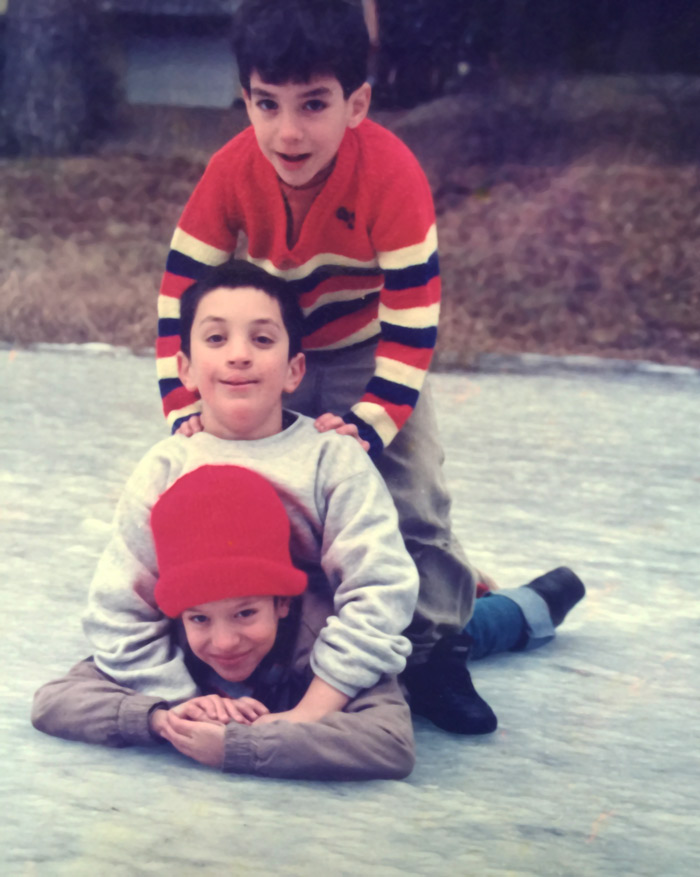 Snow fell on Alabama the other day, and bitter cold settled in. Same thing happened there back in about 1989, when Forest Lake in Tuscaloosa froze up thick enough to run around and slide on, and our three eldest posed for a picture on the ice.
Snow fell on Alabama the other day, and bitter cold settled in. Same thing happened there back in about 1989, when Forest Lake in Tuscaloosa froze up thick enough to run around and slide on, and our three eldest posed for a picture on the ice.
From the bottom: Ted, John, Joe. Note the complete absence of gloves or mittens, and the general inadequacy of winter apparel. In his hat and jacket, Ted appeared to have a chance of staying warm, but the other two just had to tough it out. There is no evidence in this picture of the socks-on-the-hands and/or plastic-bags-in-the-shoes that we recall improvising for wintry moments in Alabama; nonetheless, they all somehow survived.
Tuscaloosa
Alabama
Forest Lake
brothers
winter
John
Joe
Ted
ice
(Image credit: old family snap)
Mar 17, 2017
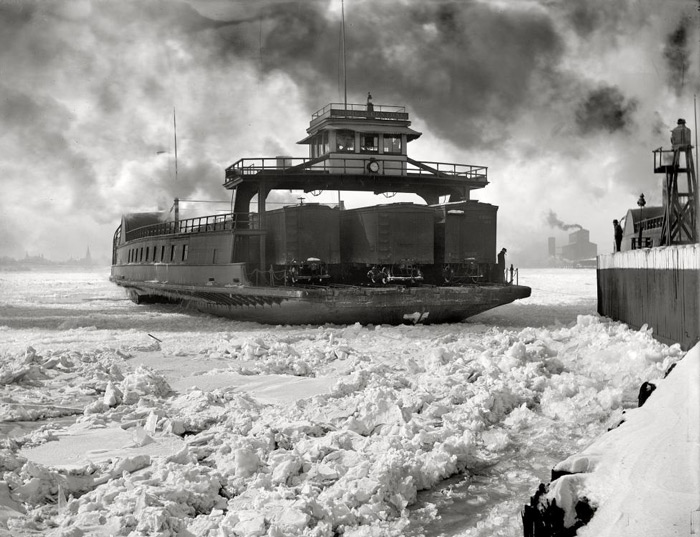 The ferry boat Michigan Central, carrying railroad cars, prepares to enter its slip on the Detroit River, circa 1900.
The ferry boat Michigan Central, carrying railroad cars, prepares to enter its slip on the Detroit River, circa 1900.
Detroit
winter
ice
ship
1900
ferry
(Image credit: Detroit Publishing Co via Shorpy)
Apr 21, 2017
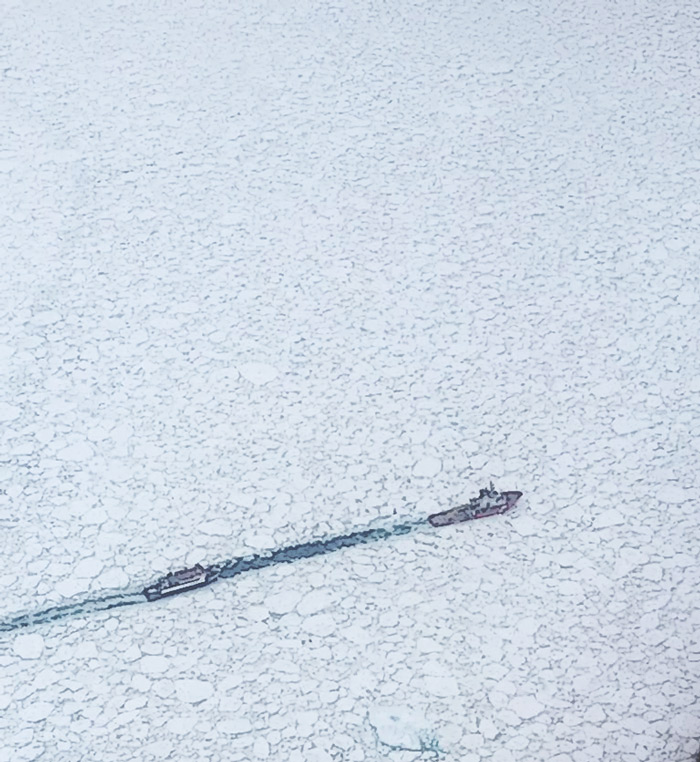 This past week, the Bell Island ferry out of Newfoundland's provincial capital of Saint John's was trapped by unusually late pack ice, requiring the ice-breaking assistance of Canadian Coast Guard vessel Earl Grey.
This past week, the Bell Island ferry out of Newfoundland's provincial capital of Saint John's was trapped by unusually late pack ice, requiring the ice-breaking assistance of Canadian Coast Guard vessel Earl Grey.
The heavy ice around Newfoundland is actually a product of global warming. Record-breaking thaws this past winter along the west coast of Greenland–including a first-ever hurricane that drenched Greenland in January–disrupted normal patterns of ice circulation on the surface of the North Atlantic.
Greenland's fast-melting glaciers spit out icebergs four months early this year, which have clogged shipping lanes. Ocean currents and winds usually break up Newfoundland's pack ice early each spring, but the unusual flow from Greenland has kept this past winter's ice trapped in harbors and coastal waters.
winter
ice
ocean
Greenland
climate change
ferries
Newfoundland
Jan 6, 2018
 In the wintry weather currently gripping eastern North America, icy mounds of frozen spray, known as sugarloaves, are growing huge atop frozen rivers below not-quite-fully-frozen waterfalls. There's a sugarloaf at the base of Niagara Falls this year, and also one at Montmorency Falls near Québec City; the falls at Montmorency are some 98 feet higher than Niagara and are located almost a thousand kilometers to the northeast, in a climate zone where every winter is plenty cold enough to make a sugarloaf.
In the wintry weather currently gripping eastern North America, icy mounds of frozen spray, known as sugarloaves, are growing huge atop frozen rivers below not-quite-fully-frozen waterfalls. There's a sugarloaf at the base of Niagara Falls this year, and also one at Montmorency Falls near Québec City; the falls at Montmorency are some 98 feet higher than Niagara and are located almost a thousand kilometers to the northeast, in a climate zone where every winter is plenty cold enough to make a sugarloaf.
The painting shown above, The Ice Cone, by Robert Clow Todd, shows Montmorency Falls and its sugarloaf in the winter of 1845. The place looked pretty much the same when we visited, in the winter of 2004, minus the horses, of course.
Tall, cone-shaped things with slightly blunted tips are often called sugarloaves, especially if they are ski resorts or a mountain in Rio de Janeiro with a statue on top. That's because real, old-school sugarloaves–actual hard, solid loaves of refined sugar–were produced in molds shaped like that. Up until the end of the nineteenth century, when manufacturing processes emerged to refine sugar into a granulated product, people who could afford to buy white sugar–meaning rich people–bought it by the loaf, which might weigh as much as 30 or 35 pounds. They chipped off pieces as needed, using heavy, sharp-edged pliers known as sugar nips.
The sugarloaves pictured below are on display in the Sugar Museum in Berlin.
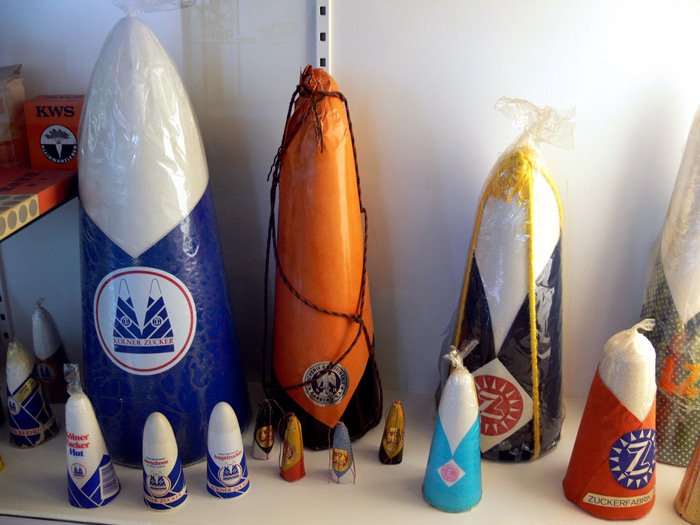
landscape
Canada
winter
snow
ice
Berlin
waterfall
Quebec
sugar
Montmorency Falls
Sugar Museum
(Art by Robert Clow Todd)
Jan 18, 2018
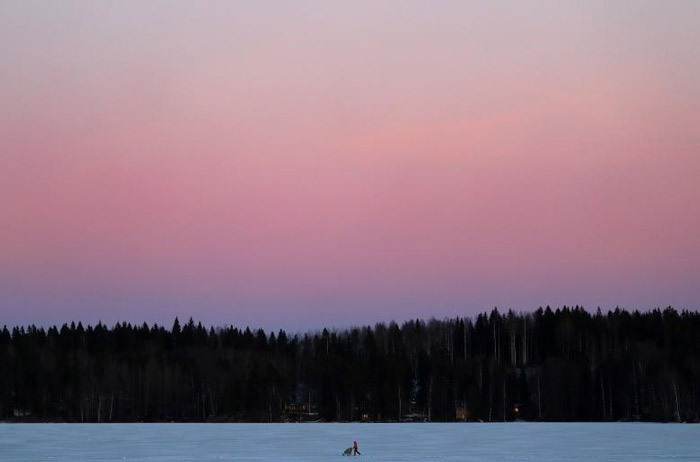 Pushing a baby stroller at sunset, across a frozen lake near Lahti, Finland.
Pushing a baby stroller at sunset, across a frozen lake near Lahti, Finland.
sunset
baby
winter
ice
lake
Lahti, Finland
stroller
(Image credit: Kai Pfaffenbach for Reuters)
Feb 13, 2018
 You'll want to watch Olympic curling this week, if only to see the Norwegians' team uniforms., which also feature matching blazers for off-ice swagger. The pictures show recent uniforms; this year's Norwegian curling trousers have been revealed, but we won't show them here out of an abundance of spoiler caution.
You'll want to watch Olympic curling this week, if only to see the Norwegians' team uniforms., which also feature matching blazers for off-ice swagger. The pictures show recent uniforms; this year's Norwegian curling trousers have been revealed, but we won't show them here out of an abundance of spoiler caution.
ice
fashion
Norway
Olympics
sport
curling





 On a cold night in January, more than two hundred firefighters from all over Chicago battled a huge blaze in the Harris Marcus warehouse in the city's Bridgeport district. The job was complicated by extreme cold, as hydrants froze and ladders iced up; the water department was called in to de-ice the ladders with steamers.
On a cold night in January, more than two hundred firefighters from all over Chicago battled a huge blaze in the Harris Marcus warehouse in the city's Bridgeport district. The job was complicated by extreme cold, as hydrants froze and ladders iced up; the water department was called in to de-ice the ladders with steamers.

 Above, wildebeest cross the Mara River during their annual migration northward from the Serengeti in Tanzania to the Masai Mara in Kenya. An estimated two million animals, mostly wildebeest but also including hundreds of thousands of Thompson's gazelle, zebra, and eland, make this long trek every year during the dry season, as they seek greener pastures; their navigation techniques are not fully understood, but one strategy they seem to follow is to head toward thunder and lightning.
Above, wildebeest cross the Mara River during their annual migration northward from the Serengeti in Tanzania to the Masai Mara in Kenya. An estimated two million animals, mostly wildebeest but also including hundreds of thousands of Thompson's gazelle, zebra, and eland, make this long trek every year during the dry season, as they seek greener pastures; their navigation techniques are not fully understood, but one strategy they seem to follow is to head toward thunder and lightning.




 This past week, the Bell Island ferry out of Newfoundland's provincial capital of Saint John's was trapped by unusually late pack ice, requiring the ice-breaking assistance of Canadian Coast Guard vessel Earl Grey.
This past week, the Bell Island ferry out of Newfoundland's provincial capital of Saint John's was trapped by unusually late pack ice, requiring the ice-breaking assistance of Canadian Coast Guard vessel Earl Grey.

 Pushing a baby stroller at sunset, across a frozen lake near Lahti, Finland.
Pushing a baby stroller at sunset, across a frozen lake near Lahti, Finland.